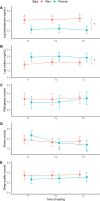Effects of a 12-week training programme on selected hormonal and psychological parameters and their interrelationships in highly-trained male and female swimmers
- PMID: 40182718
- PMCID: PMC11963123
- DOI: 10.5114/biolsport.2025.145910
Effects of a 12-week training programme on selected hormonal and psychological parameters and their interrelationships in highly-trained male and female swimmers
Abstract
Swimming training load (TL) is regarded as a major stimulus for hormonal adaptation, but research findings are inconsistent. Methodological limitations also exist (e.g., cross-sectional sampling) with little knowledge of acute hormone responses and hormone-psychological interactions that regulate training outputs. These issues were addressed in a 12-week training study on highly-trained swimmers. Eighteen swimmers (10 males, 8 females) completed a 12-week training programme, involving a stepwise reduction in TL before a major competition. Testing was conducted from Monday-Friday at week one (T1), week five (T2), and week 12 (T3), including measures of salivary testosterone and cortisol, willingness to train, stress, and sleep quality. Post-session hormones were assessed on Mondays and Fridays. Daily-averaged swimming distance decreased by -21% (T2) and -57% (T3), relative to T1 (p < 0.001). We found no significant training effect on the cortisol and testosterone measures, both baseline and acute exercise response, willingness to train, and sleep quality. Only stress varied with training, decreasing significantly at T2 and T3 from T1 in female swimmers. Among male swimmers, daily changes in baseline cortisol and testosterone were related (r = 0.45) at T1, as was sleep quality and stress (r = 0.39) at T3. In summary, highly-trained swimmers showed little or no adaptive changes prior to a major competition. The one exception was self-reported stress among female swimmers, which decreased along with TL. The emergence of daily interrelationships (in male swimmers only) between selected hormonal or psychological outputs could provide a new lens to assess pre-training preparation.
Keywords: Anxiety; Endocrinology; Overtraining; Recovery; Tapering.
Copyright © Institute of Sport – National Research Instutite.
Conflict of interest statement
The authors declare no conflict of interest.
Figures




Similar articles
-
Effect of training load on sleep parameters and biochemical fatigue markers in elite swimmers.Biol Sport. 2023 Oct;40(4):1229-1237. doi: 10.5114/biolsport.2023.124843. Epub 2023 Jun 26. Biol Sport. 2023. PMID: 37867745 Free PMC article.
-
Salivary Biomarkers and Training Load During Training and Competition in Paralympic Swimmers.Int J Sports Physiol Perform. 2018 Aug 1;13(7):839-843. doi: 10.1123/ijspp.2017-0683. Epub 2018 Jul 28. Int J Sports Physiol Perform. 2018. PMID: 29182422
-
The Effects of a 4-Week, Intensified Training, and Competition Period on Salivary Hormones, Immunoglobulin A, Illness Symptoms, and Mood State in Elite Synchronised Swimmers.Sports (Basel). 2017 Sep 1;5(3):64. doi: 10.3390/sports5030064. Sports (Basel). 2017. PMID: 29910424 Free PMC article.
-
Blood hormones as markers of training stress and overtraining.Sports Med. 1995 Oct;20(4):251-76. doi: 10.2165/00007256-199520040-00004. Sports Med. 1995. PMID: 8584849 Review.
-
Training Intensity Distribution, Training Volume, and Periodization Models in Elite Swimmers: A Systematic Review.Int J Sports Physiol Perform. 2021 Jul 1;16(7):913-926. doi: 10.1123/ijspp.2020-0906. Epub 2021 May 5. Int J Sports Physiol Perform. 2021. PMID: 33952709
References
-
- World_Aquatics . 2024: https://www.worldaquatics.com/.
-
- Santhiago V, Da Silva AS, Papoti M, Gobatto CA. Effects of 14-week swimming training program on the psychological, hormonal, and physiological parameters of elite women athletes. J Strength Cond Res. 2011; 25(3):825–32. - PubMed
-
- Tyndall GL, Kobe RW, Houmard JA. Cortisol, testosterone, and insulin action during intense swimming training in humans. Eur J Appl Physiol Occ Physiol. 1996; 73(1–2):61–5. - PubMed
-
- O’Connor PJ, Morgan WP, Raglin JS, Barksdale CM, Kalin NH. Mood state and salivary cortisol levels following overtraining in female swimmers. Psychoneuroendocrinology. 1989; 14(4):303–10. - PubMed
LinkOut - more resources
Full Text Sources
